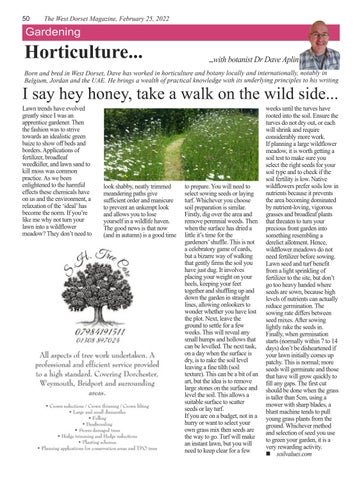50
The West Dorset Magazine, February 25, 2022
Gardening
xxxxx
Horticulture...
...with botanist Dr Dave Aplin
Born and bred in West Dorset, Dave has worked in horticulture and botany locally and internationally, notably in Belgium, Jordan and the UAE. He brings a wealth of practical knowledge with its underlying principles to his writing
I say hey honey, take a walk on the wild side... Lawn trends have evolved greatly since I was an apprentice gardener. Then the fashion was to strive towards an idealistic green baize to show off beds and borders. Applications of fertilizer, broadleaf weedkiller, and lawn sand to kill moss was common practice. As we been enlightened to the harmful effects these chemicals have on us and the environment, a relaxation of the ‘ideal’ has become the norm. If you’re like me why not turn your lawn into a wildflower meadow? They don’t need to
look shabby, neatly trimmed meandering paths give sufficient order and manicure to prevent an unkempt look and allows you to lose yourself in a wildlife haven. The good news is that now (and in autumn) is a good time
to prepare. You will need to select sowing seeds or laying turf. Whichever you choose soil preparation is similar. Firstly, dig over the area and remove perennial weeds. Then when the surface has dried a little it’s time for the gardeners’ shuffle. This is not a celebratory game of cards, but a bizarre way of walking that gently firms the soil you have just dug. It involves placing your weight on your heels, keeping your feet together and shuffling up and down the garden in straight lines, allowing onlookers to wonder whether you have lost the plot. Next, leave the ground to settle for a few weeks. This will reveal any small humps and hollows that can be levelled. The next task, on a day when the surface is dry, is to rake the soil level leaving a fine tilth (soil texture). This can be a bit of an art, but the idea is to remove large stones on the surface and level the soil. This allows a suitable surface to scatter seeds or lay turf. If you are on a budget, not in a hurry or want to select your own grass mix then seeds are the way to go. Turf will make an instant lawn, but you will need to keep clear for a few
weeks until the turves have rooted into the soil. Ensure the turves do not dry out, or each will shrink and require considerably more work. If planning a large wildflower meadow, it is worth getting a soil test to make sure you select the right seeds for your soil type and to check if the soil fertility is low. Native wildflowers prefer soils low in nutrients because it prevents the area becoming dominated by nutrient-loving, vigorous grasses and broadleaf plants that threaten to turn your precious front garden into something resembling a derelict allotment. Hence, wildflower meadows do not need fertilizer before sowing. Lawn seed and turf benefit from a light sprinkling of fertilizer to the site, but don’t go too heavy handed where seeds are sown, because high levels of nutrients can actually reduce germination. The sowing rate differs between seed mixes. After sowing lightly rake the seeds in. Finally, when germination starts (normally within 7 to 14 days) don’t be disheartened if your lawn initially comes up patchy. This is normal; more seeds will germinate and those that have will grow quickly to fill any gaps. The first cut should be done when the grass is taller than 5cm, using a mower with sharp blades, a blunt machine tends to pull young grass plants from the ground. Whichever method and selection of seed you use to green your garden, it is a very rewarding activity. n soilvalues.com







